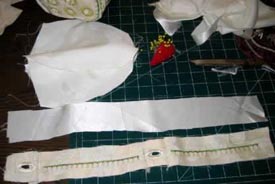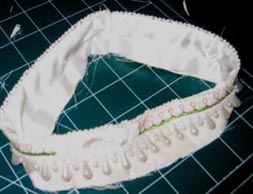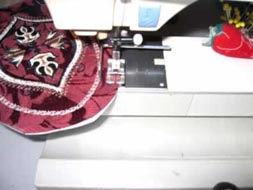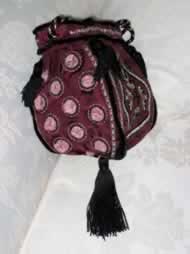Tudor Machine Embroidery Design Instructions
Tudor Bag


I stitched 2 panels of each Tudor12 and Tudor12a to make the Tudor bag. Refer to 16,17, 18 and 19 photographs for the instructions for putting the Tudor bag together.
The above photo shows the type of pearl binding used on the bag. I stitched the pearl binding around Tudor12 panel.

Tudor12 and Tudor12a panels stitched together
Many believe the colour’s that were used in the Elizabethan I period were dull colour’s, the reason for the dull colour’s was due to fading of the fabrics and embroidery threads.
The colour’s used during the early period were very bright to the point of being garish, as the silk was being shipped from China through the trade routes not through the silk road, due to the Mongol invasions.
Fine examples of the embroidery of that time is to look at photos of the stump work boxes that were produced by hand, not the out side of the boxes as the colour’s have faded over time but the inside of the stump work boxes, there you will see the beautiful silk thread and the true colour’s of the out side of the boxes

Combining all the Tudor bags panels together.

Completed stitched panels.

Close up of the pearl binding on the bag.

Combining Tudor12d for the strip to put the rope for the handles.

Template of panels for the lining of the bag.

Cut out 4 panels for the lining.

Cut out lining for the strip. I put a row of pearl binding at the top of the strip.

Stitch the lining and the strip together as shown in the photograph. Then fold the lining over and stitch a straight stitch under the decorative stitches, this is for the rope that you will be threading through at a later stage. I also decorated with drop pearls.

This is how the strip should look before you stitch the strip to the bag.

The strip stitched to the top of the bag.

Iron over the raw edge of the lining and put a simple decorative stitch over the folded edge.

Pin the strip to the lining.

Stitch by hand the two lining together.

Stitch Tudor02 (if you are making the floral bag use Tudor12a) Stitch all the circles out.
The machine will come to a stop for you to be able to take the hoop away from the machine.

Take the hoop away from the machine and cut the fabric from each circle as shown in the photograph.
Using either silk or a very fine fabric cut out 12 squares 2.5 inch or 6cm square. Have the silk squares beside you at the machine
With the first hole poke the silk up through the hole using your finger and then gently put your hoop back into your machine
Start the first colour using the same colour you used for all the holes, I decided on black thread.
This is a bit tricky I used either a plastic stick or a bamboo stick to hold the silk out of the way of the machine going around the hole. I would have my finger on the stop button at all times
After each hole the machine will stop so you can take your hoop out of the machine and put the silk in the hole

Mark with your chalk or marking pen the seam allowance from the outer border.

An easy way of marking your fabric for a seam allowance is to use the attachment as seen in the photograph to the left

On this bag I used a beautiful velvet binding



As you can see in the photo number 24 I removed the extra strip off the bag as you can see in the photo above, I did not like it, it looked a bit strange. Never be frightened of using bold lining as that can add to the over all look of your work and can look very dramatic.



Pull the cord through starting at one of the holes in the strip and bringing the cord all the way around to where you started, bring the cord through. With the other hole in the strip do the same.




Tudor Foot Stool


As you can see our bed is rather high that is the reason for the foot stool

Purchase a foot stool from your local folk art shop. Mark the centre of the stool

Mark the centre’s to the sides of the foot stool

Mark the centre of your design and also the sides of the fabric with your designs on it
Spray glue to the wadding then place the wadding to the foot stool
Match the fabric lines with the stool lines so you can get the exact centre
Staple the wadding and fabric to the stool

I purchased a few weeks ago a product from Punch with Judy I saw it at the Stitches and Craft show in Sydney. It is a pleat maker, you will now see a lot more of my work with pleats as I just love the finished look using this product, this was the first time I used the pleat maker and cannot believe how well the pleating turned out….If you are interested click on the URL below. I am not affiliated with this company at all, just love the pleater 🙂

Before the pleating I made a hem top and bottom
I glued the pleated fabric to the stool.


